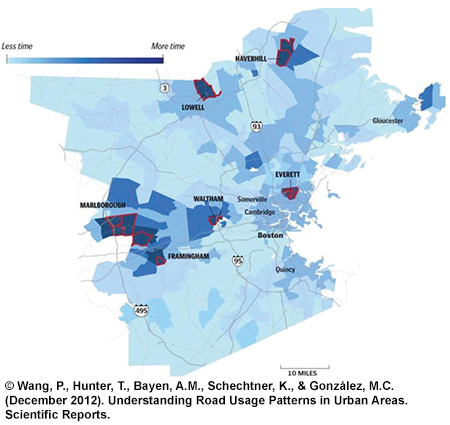U.S. Department of Transportation
Federal Highway Administration
1200 New Jersey Avenue, SE
Washington, DC 20590
202-366-4000
Federal Highway Administration Research and Technology
Coordinating, Developing, and Delivering Highway Transportation Innovations
| SUMMARY REPORT |
| This summary report is an archived publication and may contain dated technical, contact, and link information |
|
| Publication Number: FHWA-HRT-14-060 Date: July 2014 |
Publication Number: FHWA-HRT-14-060 Date: July 2014 |
In this session, researchers from various agencies and academic institutions provided descriptions of the work that they have been conducting and their uses of linking cellular and other mobile data with behavior and environment data. Symposium participants then discussed challenges relating to land use and margins of error.
Presentations
Lei Zhang, University of Maryland
Lei Zhang’s focus has been to research trip purpose by using passively collected data and by attaining varying trip characteristics and details depending on the model. Zhang linked the 1995 American Travel Survey and cell data for urban trips. Zhang found that the most difficult types of trips to categorize were personal in nature, because there is less of a pattern. His model utilized land use, time of day, and duration and works fairly well across regions. Zhang noted that a useful next step would be linking the data in terms of a time series.
Billy Bachman, Westat
Billy Bachman focused on what can be learned from GPS data in conjunction with travel surveys. He highlighted that developing the link to behavior is important for building forecasts and determining future movement. A challenge that Bachman noted included ensuring that the data stream is uninterrupted or does not contain missing data. This is a specific area in which cellular data could prove to be beneficial. Integrating cellular data into traditional survey approaches could be particularly beneficial in filling in gaps and answering lingering questions.
Shan Jiang, Massachusetts Institute of Technology
Shan Jiang worked on extracting data from cellular devices to link trips to activity. This included looking at possible nodes for daily travel, which typically consisted of home and work. In addition, Jiang linked the data to census tract data with the goal of determining the most heavily impacted roadways in terms of traffic to target congestion reduction, as shown in figure 6. Jiang noted that a key challenge is validating cell phone inferred results with survey and GPS data.

Figure 6. Road usage based on cell phone data linked with census tracts to illustrate congestion exposure.
The symposium participants discussed several major themes during this session, as follows:
The symposium participants noted several key takeaways during the discussion, as follows: